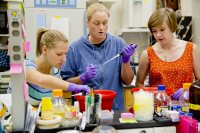
Bates welcomes new faculty: Brett Huggett, biology

Brett Huggett, assistant professor of biology. (Sarah Crosby/Bates College)
For Brett Huggett, the Appalachian Trail was more than a path from Georgia to Maine. This 2,184-mile walk in the woods also led him toward his career.
Three years after graduating from Temple University with a degree in music, Huggett took a vacation from performing and teaching jazz guitar to hike the legendary trail.
“It was a pivotal experience,” says Huggett, a plant physiologist and tree specialist who joined the Bates faculty as assistant professor of biology in summer 2014. “It gave me a long-enough break from music and a large-enough taste of the forest ecosystems along the East Coast.
“Pretty quickly after finishing the trail, I decided to switch careers.” Soon thereafter he found his focus, thanks to a winter ecology course at the Center for Northern Studies, in Vermont.
Read more profiles of tenure-track faculty new or returning to Bates in 2014:
- Katharine Ott, assistant professor of mathematics
- Geneviève Robert, assistant professor of geology
- Michael Rocque, assistant professor of sociology
- Nathan Tefft, assistant professor of economics
“That’s where I was introduced to tree physiology and the mechanisms that allow a tree to deal with subfreezing temperatures. And that really sparked my desire to pursue this field.”
Huggett left his music career behind in Philadelphia and set out on a different kind of trail: a series of jobs and night classes, and ultimately advanced degrees, designed to position him for his current gig.
He was a teacher and naturalist for the Massachusetts Audubon Society; a ranger and land manager for the town of Lincoln, Mass.; and a curatorial and lab assistant at the Harvard University Herbaria. Ultimately Huggett earned a master’s degree in forest biology from the University of Vermont, and a doctorate in organismic and evolutionary biology from Harvard.
Today he studies arboreal vascular systems, anatomy and nutrient processing. “My research explores the physiological adaptations of trees to stress, and I conduct most of that research in New England,” he says.
He’s currently looking at how trees of various species store carbohydrates. “This gives us a better idea of how trees might change their physiology in response to long-term climate change.”
Huggett is also investigating the impacts in Maine of a destructive insect, the hemlock woolly adelgid. Introduced from Asia and closely related to the aphid (the insect every gardener loves to hate), the woolly adelgid feeds on and kills hemlocks.
Adelgids are found in 18 states from Georgia to Maine, where they’ve been reported in five southern and coastal counties. The trend toward milder winters has made life easier for the adelgid here.
“It’s a sad story,” Huggett says. “It’s thought that there’s no way to repair the situation — many of the large hemlock stands will eventually die.”
The hemlock is the third-most valuable harvested tree species in Maine, according to a 2013 article in the Portland Press Herald. The value of trees — ecological, aesthetic and recreational as well as economic — gives Huggett a sense of mission in his work. (He has also studied the effects of acid rain on one of the region’s most iconic trees, the sugar maple.)
The fundamental appeal of trees also affords a head start in the campaign to win hearts and minds to Huggett’s field. “People are concerned about and attracted to New England forests,” he says. “It’s a good vehicle to get students excited about biology.”
Students, of course, play a valuable role in Huggett’s research. “The focus is to give them hands-on experience in collecting data. For my current research, that will be collecting leaf, trunk and root tissue of various species to measure changes in carbon allocation in response to environmental stress.”
And while Huggett allows that technological advances are adding excitement to his field along with so many others, he finds it refreshing that he and his students can still do meaningful research — on tree vascular systems, for instance — with tried and true tools: a razor blade to section a sample of tree tissue, a dollop of histological stain to make cell structures apparent and a microscope to scrutinize it all with.



